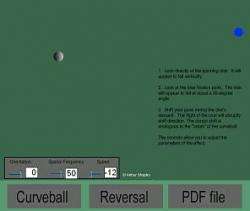May 13, 2009 weblog
Best Visual Illusion of the Year: How a Curveball Works

(PhysOrg.com) -- Visual illusions sometimes seem to have a magical element to them, but they're actually just the brain's way of interpreting reality. In an effort to promote public knowledge of cognitive research, as well as medical discoveries of sensory and cognitive experience, the Neural Correlate Society hosted its 5th annual "Best Visual Illusion of the Year" Contest last Sunday evening, May 10th, at the Philharmonic Center for the Arts in Naples, Florida. The Mind Science Foundation sponsored the event.
Visual artists and scientists from all around the world submitted novel visual illusions, and an international panel of judges narrowed them down to the top 10. At the Contest Gala in Naples, more than 1,000 voters chose the top three winners. Voters included members of the public, as well as researchers who had attended a conference that week held by the Vision Sciences Society. The winners are:
1st prize: "The Break of the Curveball" by Arthur Shapiro, Zhong-Lin Lu, Emily Knight and Robert Ennis (American University, Bucknell University, University of Southern California, Dartmouth College, and SUNY College of Optometry, USA)
2nd prize: "Color Dove Illusion" by Yuval Barkan and Hedva Spitzer (Tel-Aviv University, Israel)
3rd prize: "The Illusion of Sex" by Richard Russell (Harvard University, USA)
The three winning illusions, along with the top 10 finalist illusions, can be seen at http://illusioncontest.neuralcorrelate.com.
The top three winners received a "Guido" trophy, designed by the Italian sculptor Guido Moretti. Sunday's Contest Gala also included a magic performance by the world famous magician and escapologist James Randi (a.k.a. "The Amaz!ng Randi").
"The contest is a celebration of the ingenuity and creativity of the world's premier visual illusion research community," the contest's website explains. "Visual illusions are those perceptual experiences that do not match the physical reality. Our perception of the outside world is generated indirectly by brain mechanisms, and so all visual perception is illusory to some extent. The study of visual illusions is therefore of critical importance to the understanding of the basic mechanisms of sensory perception, as well as to cure many diseases of the visual system."
At the contest's website, visitors can send free e-cards with visual illusions, as well as view winning illusions from previous contests since 2005.
© 2009 PhysOrg.com


















